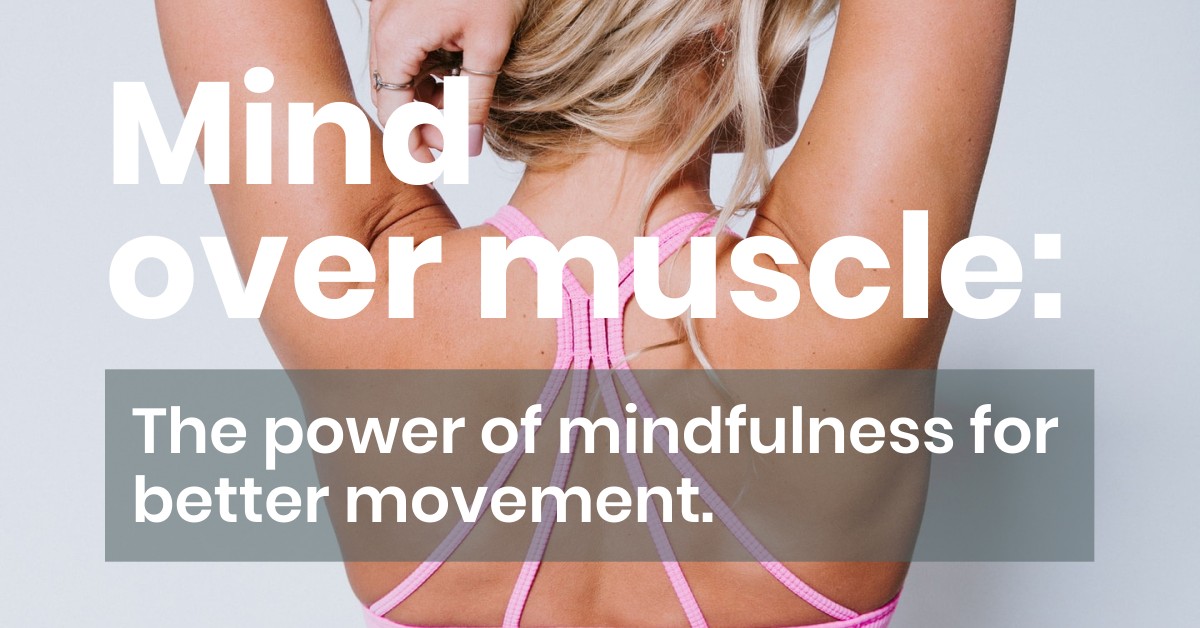
Mind over muscle: The power of mindfulness for better movement
How well do you move? That might sound like an odd question, but think about it for a moment. Do you move about effortlessly, free from pain and restriction? Or do you sometimes move about uncomfortably and possibly awkwardly, with pain or stiffness in some of your joints?
With demanding lifestyles, including jobs where we might spend all day sitting stooped over a desk, stretching, sitting in a cramped position, climbing ladders or lifting heavy objects, it’s little wonder that we might put our hands up at the latter.
Movement is essential as a human being, and if your freedom of movement is somewhat inhibited, then perhaps an ancient type of meditative practice called mindfulness could help. Practising mindfulness is beneficial for calming the mind, but research suggests that it could also be beneficial in a physical way.
A theory based on mindfulness called the mind-muscle connection suggests that we may have a better ability to perform certain movements when we’ve visualised them first. This is helpful in exercise and training, which can then boost muscle growth. Larger muscles mean better motor control, helpful for movement in everyday life.
The theory suggests that paying more attention to the muscles we’re working on can help us improve our muscle mass. So, could thinking harder about each muscle as we train it, be improved by mindful concentration?
Does brain have to compete with brawn? Or can the two work together? The science certainly suggests that they can…
What exactly is mindfulness?
Mindfulness is a term that’s used in common parlance in today’s manic and rushed world, but it’s not always well understood. It’s perhaps easier to define mindfulness as what it isn’t… Mindfulness isn’t sitting cross legged with your eyes shut in front of an Instagram worthy backdrop of mountains and lakes. It can be, but it certainly doesn’t have to be.
Mindfulness isn’t about completely emptying your mind of all thoughts, either. Instead, it’s about focusing your mind on the present, on the here and now. Practising mindfulness involves listening to your body, by for example following your breath, and if thoughts and feelings do enter your mind, allow them to come before passing them on their way.
Another way of focusing your attention inward is to practice an internal focus on your muscles during exercise to help promote the so-called mind-muscle connection.
What is the mind-muscle connection?
Also known as attentional focus or internal focus, the mind-muscle connection is a theory that, in order to be successful, requires us to concentrate on the contraction of each muscle as we work it.
So, for example, if you were lifting a free weight in your right hand, performing say, a bicep curl, you would focus all of your attention on the action of your bicep muscle in your right arm as you squeeze it in order to lift the weight.
To work your muscles alongside the mind-muscle connection, you’re concentrating on an internal focus, rather than external focus. In the case of a bicep curl, the external focus would be focusing on the weight as it lifts. To reiterate, internal focus is a focus on your bicep and how it feels as you lift, external focus is the focus on the weight as it moves up and down.
Internal focus is the lynchpin of the mind-muscle connection.
In other words, how the exercise feels is just as important as paying attention to how to actually perform a certain exercise or movement.
The focus is on the feel of the muscle by using mindfulness (so in this case, focusing on how a muscle such as the bicep feels when you’re contracting it, rather than your breathing) in order to help muscular strength and development.
Which is great if you’re trying to build up your muscles! But is this just a theory, or does it actually work?
What does the science say?
Research backs up the theory of the mind-muscle connection, with one particular study concluding that their findings, “lend support to the use of a mind–muscle connection to enhance muscle hypertrophy”.1
Hypertrophy is the scientific name given to the increase and growth of muscle cells, and therefore muscles, through exercise. This study looked at the difference that having an internal focus on a muscle had over an external focus on the outcome of the exercise.
After eight weeks, the two different groups were given an ultrasound to measure muscle thickness in the elbow flexors and quadriceps. Researchers found that muscle thickness in both sets of muscles was significantly increased in the internal focus group when compared to the external focus group.
Another study found that athletes focusing internally on their obliques and abs whilst exercising were able to demonstrate greater muscular activity using electromyography that measures muscle response.2
Further still, another study has concluded that individuals can increase muscle activity during bench presses by up to 60% when focusing internally on their triceps and pecs.3
So, what about the benefits of this for our everyday movement and motor control?
What is motor control and why is this helpful for everyday life?
Exercise is an important part of living a healthy life as well as getting into good health and staying there, even if we’re experiencing symptoms of a condition we may have.
By exercising mindfully, with an internal focus on the mind-muscle connection to increase muscle size, then we can help to improve our overall health – by improving our motor control.
Motor control describes the process by which we regulate movement using our nervous system – both controlled movement, such as lifting a weight, or involuntary reflexes such as scratching or sneezing.
An improvement in motor control has a double benefit. It will work in a virtuous cycle in exercise, allowing us to improve our skills and sport specific movement. Plus, it will improve all the activities we need to carry out during our daily living.
This is because an improvement in motor control helps us to move better, more safely (avoiding trips, slips and falls) and more efficiently. A win-win for mindful exercise and the mind-muscle connection!
New evidence also suggests that visualisation could be a powerful tool for improving our motor skills, too. One paper, published in 2020, determined that, “visualisation techniques can improve motor skills, grow muscle strength, increase self-confidence and attention concentration and decrease anxiety”.4
Visualisation involves using mental imagery (and all five senses) to depict ourselves doing something or being somewhere. In this study, the authors used the example of athletics, tennis and swimming among other sports. They conclude that through the use of imagery, we can improve not only our physical performance but our motivation, endurance and pain management too. This is because “the subconscious processes the experience as a real one”.
The new muscle memory?
Mind over muscle really is a possibility. Next time you’re exercising to increase muscle size, try focusing your attention on how your muscles feel as they work. You could be helping to increase their size and in turn help to improve your motor control and everyday movement.
References
1. Schoenfeld, B., Vigotsky, A., Contreras, B. and Golden, S., 2018. Differential effects of attentional focus strategies during long-term resistance training. European Journal of Sports Science, 2018, Mar; 18(5):1-8 [Accessed 15 October 2021].
2. Schoenfeld, B. and Contreras, B., 2016. Attentional Focus for Maximizing Muscle Development. Strength & Conditioning Journal, 38(1), pp.27-29 [Accessed 15 October 2021].
3.Calatayud, J., Vinstrup, J., Due Jakobsen, M., Sundstrup, E., Brandt, M., Jay, K., Colado, J. and Andersen, L., 2016. Importance of mind-muscle connection during progressive resistance training. European Journal of Applied Physiology, 2016 Mar;116(3):527-33 [Accessed 15 October 2021].
4. Predoiu, R., Predoiu, A., Mitrache, G., Firanescu, M., Cosma, G., Dinuta, G., Bucuroiu, R., 2020. Visualisation Techniques in Sport – the Mental Road Map for Success. Physical Education, Sport and Kinetotherapy Journal, 2020; 59(3):245-256 [Accessed 15 October 2021].


